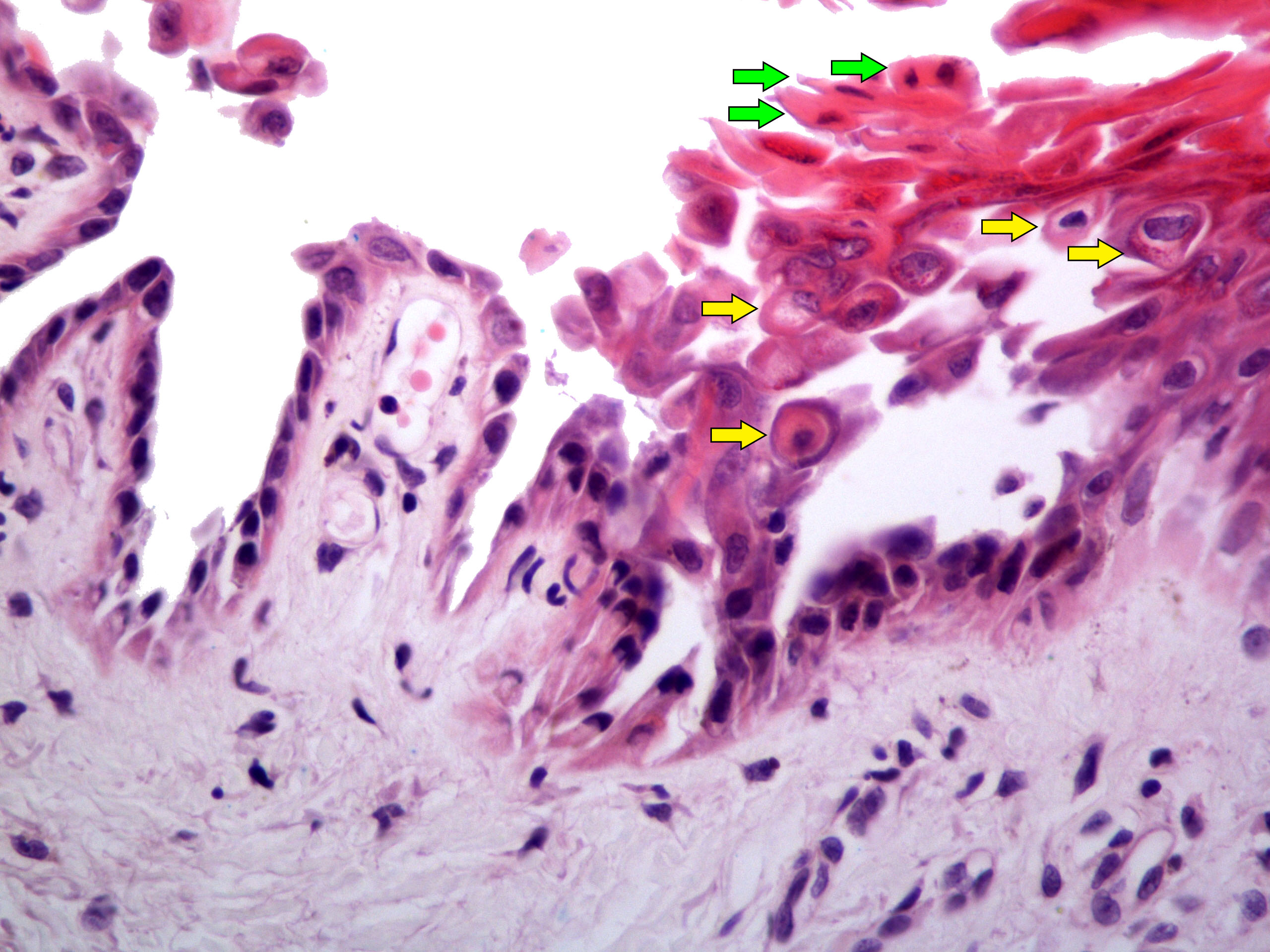Table of Contents
Definition / general | Essential features | Terminology | ICD coding | Epidemiology | Sites | Pathophysiology | Etiology | Clinical features | Diagnosis | Prognostic factors | Case reports | Treatment | Clinical images | Microscopic (histologic) description | Microscopic (histologic) images | Positive stains | Molecular / cytogenetics description | Sample pathology report | Differential diagnosis | Additional references | Board review style question #1 | Board review style answer #1 | Board review style question #2 | Board review style answer #2 | Board review style question #3 | Board review style answer #3Cite this page: McNish A, Fitz-Henley M, Ho JD. Keratosis follicularis (Darier disease). PathologyOutlines.com website. https://www.pathologyoutlines.com/topic/skinnontumordariersdisease.html. Accessed April 2nd, 2025.
Definition / general
- Autosomal dominant genodermatosis
- Clinical: greasy keratotic papules in a seborrheic distribution, nail changes and mucosal findings
- Histologic: acantholytic dyskeratosis
Essential features
- Autosomal dominant genodermatosis due to mutations in ATP2A2 gene
- Clinical features: family history, greasy hyperkeratotic papules in a seborrheic / flexural / acral distribution, mucosal lesions and nail changes
- Histologic features: acantholytic dyskeratosis with corp rond and grain formation
- Clinical correlation is crucial to distinguish from mimickers with identical histopathologic features
Terminology
- Darier-White disease, keratosis follicularis and dyskeratosis follicularis
ICD coding
Epidemiology
- Worldwide distribution (Br J Dermatol 2002;146:107)
- Prevalence varies regionally between 1:30,000 and 1:100,000 (Br J Dermatol 2002;146:107, Br J Dermatol 1992;127:126)
- M = F
Sites
- Seborrheic distribution: central chest, back, marginal scalp and face
- Dorsal hands
- Palms and soles
- Oral cavity
- Nails
- Intertriginous skin
Pathophysiology
- Autosomal dominant mutations in ATP2A2 gene (Hum Mutat 2017;38:343)
- ATP2A2 encodes the sarco / endoplasmic reticulum Ca2+ ATPase isoform 2 (SERCA2) (Hum Mol Genet 1999;8:1611)
- Abnormal SERCA2 results in endoplasmic reticulum stress and impaired formation of keratinocyte adhesion proteins (J Invest Dermatol 2014;134:1961)
- Resultant lack of epidermal integrity with acantholysis and impaired keratinization (Biochim Biophys Acta 2011;1813:1111)
Etiology
- Autosomal dominant mutations in ATP2A2 gene (Hum Mutat 2017;38:343)
Clinical features
- Onset 6 - 20 years (J Am Acad Dermatol 1992;27:40)
- Keratotic, red-brown papules on the trunk, face, neck and intertriginous areas; often malodorous
- Hypopigmented macules may predominate in darker skin types (JAAD Case Rep 2018;4:262)
- Flat topped acral papules and palmoplantar pits are common
- Nail changes: longitudinal erythro / leukonychia, subungual hyperkeratosis and V shaped nicking of the free edge of the nail (J Am Acad Dermatol 1992;27:40)
- White papules involving the hard palate, buccal mucosa or tongue
- Mucosal disease may be associated with salivary gland swelling (Br Dent J 1991;171:133)
- Less common presentations include acral hemorrhagic lesions, segmental lesions and comedonal variants (Actas Dermosifiliogr 2017;108:e49, Clin Case Rep 2019;7:1362, J Dermatol 2019;46:e211)
- Associated with neuropsychiatric conditions, particularly mood disorders (Br J Dermatol 2010 Sep;163:515)
Diagnosis
- Family history
- Mucocutaneous findings
- Skin biopsy
- PCR DNA amplification to detect ATP2A2 mutations (Mol Med Rep 2015;12:1845)
Prognostic factors
- Chronic, with intermittent exacerbations and no tendency for resolution (J Dermatol 2016;43:275)
- Prone to secondary bacterial, viral and fungal colonization / infections (J Eur Acad Dermatol Venereol 2013;27:1405, Am J Dermatopathol 2017;39:370, Dermatol Ther 2020;33:e14500, Br J Dermatol 2015;172:837, Acta Derm Venereol 2017;97:139)
- Increased morbidity from associated mood disorders (Br J Dermatol 2010;163:515)
- Increased risk of squamous cell carcinoma within affected skin (Br J Dermatol 2008;159:1378, Clin Exp Dermatol 2009;34:e1015)
Case reports
- 28 year old woman, 50 year old man and 60 year old woman presenting with acral hemorrhagic lesions (Actas Dermosifiliogr 2017;108:e49)
- 31 year old woman with asymptomatic acneiform papules on the face (Ann Dermatol 2011;23:S398)
- 48 year old woman with worsening of Darier disease after interferon alpha treatment (Case Rep Dermatol 2016;8:218)
- Man in his 50s with leonine face and keratotic papules all over his body, a condition present since childhood (Case of the Month #517)
- 67 year old woman with segmental Darier disease treated with doxycycline (Dermatol Online J 2018;24:13030)
Treatment
- Mild disease: topical agents, including retinoids, vitamin D analogues and calcineurin inhibitors (Pediatr Dermatol 2011;28:197, J Dermatol 2010;37:718, Eur J Dermatol 2011;21:301)
- Systemic retinoids (Indian J Dermatol Venereol Leprol 2021;87:14)
- Laser ablation (Arch Dermatol 1999;135:423)
- Botulinum toxin injections (Orphanet J Rare Dis 2021;16:93)
Clinical images
Microscopic (histologic) description
- Parakeratosis
- Variable epidermal thickness
- Acantholysis with characteristic dyskeratosis forming corp ronds and grains
- Corp rond: rounded keratinocyte in superficial spiny and granular layer with basophilic / pyknotic nucleus, perinuclear halo and often a rim of eosinophilic cytoplasm (J Dermatol 2017;44:232)
- Grain: elongated keratinocyte in the stratum corneum with small basophilic nuclei and intensely pink cytoplasm; appears as plump parakeratosis; may form tiers (J Dermatol 2017;44:232)
- Corp rond and grain type dyskeratosis is classical but not specific for Darier disease (see Differential diagnosis)
- Suprabasal acantholysis and clefting with retained single layer of basal keratinocytes overlying dermal papillae which appear to project into the acantholytic cavity (villi) (J Dermatol 2016;43:275)
- Frank bullae may occur in cases with extensive acantholysis and large clefts (Arch Dermatol 1982;118:278)
- Superimposed fungal, bacterial and herpetic infections may be seen (J Eur Acad Dermatol Venereol 2013;27:1405, Am J Dermatopathol 2017;39:370, Dermatol Ther 2020;33:e14500, Br J Dermatol 2015;172:837, Acta Derm Venereol 2017;97:139)
- Variable mild perivascular inflammatory cell infiltrate
- Variants: extensive pseudoepitheliomatous hyperplasia, comedonal lesions with prominent villus formation and hemorrhagic bullous lesions (Am J Dermatopathol 2015;37:323, J Dermatol 2006;33:477, J Cutan Med Surg 2016;20:478)
- Flat topped acral papules demonstrate orthokeratosis (may be church spire type), hypergranulosis and papillomatous epidermal hyperplasia; acantholytic dyskeratosis is often subtle or absent
Microscopic (histologic) images
Positive stains
- PAS stain - should be performed to rule out superimposed fungal infections but may not always be positive
Molecular / cytogenetics description
- > 270 unique ATP2A2 mutations described (missense / nonsense > deletion / splice site / insertion mutations) (PLoS One 2017;12:e0186356, Hum Mutat 2017;38:343)
Sample pathology report
- Skin of chest, punch biopsy:
- Darier disease (see comment)
- Comment: The specimen exhibits parakeratosis, epidermal hyperplasia, acantholytic dyskeratosis with prominent corp rond and grain formation, suprabasal clefting with formation of villi and a mild superficial perivascular lymphocytic infiltrate. Although similar acantholytic dyskeratosis may be seen in a number of entities, given the clinical history of greasy papules in a seborrheic distribution, a positive family history and persistence of lesions, the findings are most consistent with Darier disease.
Differential diagnosis
- Hailey-Hailey disease:
- Intraspinous to full thickness acantholysis
- Less prominent dyskeratosis
- Dilapidated brick wall appearance
- Acrokeratosis verruciformis of Hopf:
- Church spire hyperkeratosis, hypergranulosis and papillomatous epidermal hyperplasia
- Lesions may be identical to flat topped acral papules of Darier disease (J Dermatol 2016;43:275, J Invest Dermatol 2003;120:229)
- No acantholytic dyskeratosis seen
- Pemphigus vulgaris:
- Suprabasal and intraspinous acantholysis without corp rond and grain formation
- Intraepidermal, intercellular deposition of IgG/C3
- Transient acantholytic dermatosis (Grover disease):
- May have identical histopathologic features
- Distinction is easy based on clinical features (relapsing remitting pruritic papular eruption in middle aged to elderly males)
- Warty dyskeratoma:
- Identical Darier type acantholytic dyskeratosis but solitary lesion
- Tends to have distinct cup shaped epidermal invagination and very prominent villus formation (J Dermatol 2017;44:232)
- Acantholytic dyskeratotic acanthoma:
- Darier or pemphigus type acantholytic dyskeratosis but solitary papule or nodule; rarely erythronychia (J Cutan Pathol 2007;34:494)
- Regular acanthosis without a cup shaped invagination (Dermatol Pract Concept 2014;4:25)
- Acantholytic dermatosis of the genitocrural area:
- Darier or Hailey-Hailey type histopathologic appearance
- Limited to the genitocrural area
- No other clinical features of heritable acantholytic disease
- Focal acantholytic dyskeratosis:
- Incidental acantholytic dyskeratosis without a clinical correlate of an acantholytic condition (J Am Acad Dermatol 1998;38:243)
- May be seen in normal skin or adjacent to a variety of benign or malignant tumors (J Am Acad Dermatol 1998;38:243)
Additional references
Board review style question #1
Board review style answer #1
A. Darier disease. The photomicrograph shows acantholysis with dyskeratosis (corp ronds and grains) as well as the formation of villi classically seen in Darier disease. While Hailey-Hailey disease may have acantholysis with dyskeratosis, prominent corp ronds and grains are lacking. Pemphigus has bland acantholysis and herpes simplex shows distinct viral cytopathic change. Seborrheic dermatitis is a spongiotic dermatitis.
Comment Here
Reference: Darier disease
Comment Here
Reference: Darier disease
Board review style question #2
Which of the following diseases may demonstrate histopathologic features identical to Darier disease?
- Grover disease
- Hailey-Hailey disease
- Inflammatory and linear verrucous epidermal nevus
- Pemphigus foliaceus
- Pemphigus vulgaris
Board review style answer #2
A. Grover disease. Grover disease has multiple histopathologic patterns including those with Darier type histology. All other options lack typical corp rond and grain formation.
Comment Here
Reference: Darier disease
Comment Here
Reference: Darier disease
Board review style question #3
Where is the abnormal protein located in Darier disease?
- Cytoplasm
- Endoplasmic reticulum
- Golgi apparatus
- Mitochondria
- Nucleus
Board review style answer #3
B. Endoplasmic reticulum. An abnormal SERCA2 protein is located in the endoplasmic reticulum and plays a role in the Ca2+ signaling pathway regulating cell to cell adhesion and differentiation of the epidermis (Nat Genet 1999;21:271).
Comment Here
Reference: Darier disease
Comment Here
Reference: Darier disease


